
The leader in
news and information on
low energy nuclear reactions
January 10, 2007 -- Issue #20
Copyright 2007 New Energy Times (tm)
Published by the New Energy Institute Inc. six times per year
Staff
Editor and Publisher: Steven B. Krivit
Copy Editor: Cindy Goldstein
Web Editor: Sally Robertson
Science Advisers:
Edmund Storms
John Armstrong
Support Team
Randy Souther
H.P.
Nick Palmer
V.F.
John Rudiger
Nick Tate
Contributors
Charles G. Beaudette
Conrado Salas Cano
Carla Salas Cano
New Energy Times (tm)
11664 National Blvd. Suite 142
Los Angeles, CA 90064
(310) 470-8189
|
New Energy Times (tm) is a project of New Energy Institute, an independent 501(c)(3) nonprofit corporation that provides information and educational services to help bring about the clean-energy revolution.
|
__________________________________________________________________________________
New Energy Institute gratefully acknowledges the generosity and support of our major sponsors:
Anonymous Fund c/o The Denver Foundation
The Macaulay Group of Texas Companies
Mike Carrell
John Miranda
Two Anonymous Contributors
__________________________________________________________________________________
New Energy Institute is pleased to award grants to:
The International Society for Condensed Matter Nuclear Science
The LENR-CANR.org Library
__________________________________________________________________________________
EDITORIALS AND OPINION
1. From the Editor
2. To the Editor
NEWS & ANNOUNCEMENTS
3. The 13th International Conference on Condensed Matter Nuclear Science (ICCF-13)
4. Other Upcoming Conferences
5. Excerpts from Cold Fusion: Fire from Water on Google Video
6. What Really Happened with Cold Fusion, and Why Is It Coming Back?
7. Glenn T. Seaborg Describes His Role in Advising President George H.W. Bush on Cold Fusion
ANALYSIS AND PERSPECTIVES
8. The Cold Fusion Short Story
9. Low Energy Nuclear Reactions and Condensed Matter Nuclear Science Defined
10. My Cold Fusion Talk at the Atheneum of Madrid by Conrado Salas Cano
11. SCIENCE AND ENERGY NEWS
__________________________________________________________________________________
“I believe that cold fusion research is like the finger pointing at the moon, only silly people look at the finger, wise people look at the moon. This phenomenon sheds a new light on the physics of condensed matter and can be the gate for a new revolution in physics. Don't believe that physics is just the challenge in measuring with higher accuracy what is already known.”
— Antonella De Ninno |
__________________________________________________________________________________
EDITORIALS AND OPINION
1. From the Editor: On Replication
By Steven Krivit

Photo: Daniel Bosler |
[This is a review as well as an applied discussion of the concepts in "Changing Order; Replication and Induction in Scientific Practice" by Harry M. Collins, Sage, 1985, Univ. of Chicago Press, 1992]
Rejecters of the hypothesis of low energy nuclear reactions point to the failure of these experiments to be easily replicable as the primary reason for their dismissal of the entire field as artifact, as pseudoscience.
In the absence of other convincing information, this is a legitimate point of view, and it can, in some circumstances, prevent the waste of time and resources. |
Accepters of the hypothesis of low energy nuclear reactions see the failure to be easily replicable as a disappointing frustration. Many of these researchers have dedicated every resource availble to them over the last 18 years to uncover the mystery colloquially known as cold fusion.
A significant experimental result -- one that appeared to contradict understanding of physics and chemistry going back hundreds of years -- was presented by Pamela Mosier-Boss, Frank Gordon and Stan Szpak last year.
These researchers, from the Space and Naval Warfare Systems Center in San Diego, Calif., presented their astonishing claims at the National Defense Industrial Association and Office of Naval Research 2006 Naval Science & Technology Partnership conference in Washington, D.C., on Aug. 2, 2006.
Nuclear reactions, as we know them today, are typically created in enormous laboratory apparatus, using very high energy sources to generate the reactions. To people familiar with the topic of conventional nuclear reactions, the idea that low energy nuclear reaction researchers can effect a nuclear reaction with three volts at 100 milliamps and a pair of rare-earth magnets or an external electric field ranks right next to parapsychology (psychokinesis, telepathy, clairvoyance) as far as scientific believability.
A colleague of someone on the SPAWAR research team told him after the conference, "If a stranger had told me the things you did, I would not have believed them."
Although trusted personal relationships are helpful in situations with surprising results, they get you only so far. In science, through the use of the scientific method, we have come to know, understand and accept certain knowledge of the world around us.
At the core of the scientific method is the idea of reproducibility. Can a claimant, the originator of an observed phenomenon, specify an instruction set which will permit any person skilled in the particular art, a replicator, to achieve the same result?
Since March 23, 1989, when Martin Fleischmann and Stanley Pons announced their discovery of an anomalous source of energy at the University of Utah, numerous challenges have been presented by skeptical observers. Over time, persistent researchers have overcome nearly every one of the challenges.
Initially, the challenge was, "Why doesn't this experiment show the byproduct of a nuclear fusion reaction?" When researchers explained that the experiment does indeed yield a nuclear byproduct, albeit an unexpected byproduct, other challenges were presented. "Can it be demonstrated that the claimed byproduct is related to the claimed energy released?" When this challenge was met, others were presented. And so it has been for 18 years: challenge and response, challenge and response.
Very few challenges remain unmet. Perhaps the only significant challenge that exists is whether this field can offer a replicable experiment. (The challenge of commercial viability is not a scientific challenge but an engineering challenge.)
The journal Nature published an article last year on the challenge of replication. It referenced Harry M. Collins, who is an expert on replication.
The Nature article published just as I was setting up The Galileo Project, a coordinated worldwide attempt to replicate the SPAWAR experiment (New Energy Times, Issue #19). The matter of independence has come under fire in recent years with related research in nuclear physics. Consequently, I was interested in obtaining Collins' expert opinion on a definition of "independence" as it pertains to scientific replications.
I asked Collins, "How does one define 'independent,' as it pertains to a scientific replication? I suspect the answer is not black-and-white and that there are gray areas."
I proposed to him a four-level stratification of "independence."
Criterion for Independence of Replications
HIGHEST INDEPENDENCE
Replicator has no direct contact with originator and his/her laboratory.
The only conduit of information is through a fixed document or recording.
No tools or materials are provided to replicator by originator.
Originator and replicator never enter each others' laboratory.
HIGH INDEPENDENCE
Replicator may have some contact with originator.
Some tools or materials may be provided to replicator by originator.
Originator and replicator never enter each others' laboratory.
MODERATE INDEPENDENCE
Replicator may receive personal training from originator in originator's
laboratory.
Some tools or materials may be provided to replicator by originator.
Originator and replicator never enter each others' laboratory.
LOW INDEPENDENCE
Originator has no hands-on involvement in experiment or analysis of the
results.
Some tools or materials may be provided to replicator by originator.
Replicator may have access to or receive specialized instruction from originator.
Collins did not provide his definition for "independence" but did confirm my proposal.
"This is an excellent question, and the suggestions you make are sensible," Collins said. "But the matter is embedded within a web of much larger questions. I suggest you look at my book."
Repeatable, Replicable, Reproducible
I took Collins up on his suggestion. I found his book to be extremely resourceful. I was initially surprised by its depth and complexity. Collins excels in providing both the conceptual models and his own first-hand experience in the subject matter.
Collins begins the chapter on replication by quoting philosopher Sir Karl Popper: "Only when certain events recur in accordance with rules or regularities, as in the case of repeatable experiments, can our observations be tested."
Collins also alerts us to the limitation of the above edict, stated by Popper himself: "All repetitions which we experience are approximate repetitions; and by saying that a replication is approximate I mean that the repetition B of an event A is not identical with A, or indistinguishable from A, but only more or less similar to A."
Collins presents a good point: There are limits to how identical a replication can be, because all replications will have at least an unidentical parameter of time or space.
Collins also presents a useful philosophy stated in 1926 by a psychologist named Dennis: "Proof in science is merely repeatability. . What has occurred once under given conditions will occur again if the same conditions are established. . The only question concerns the accuracy and completeness of the statement of conditions. . Proof has not begun until the conditions of the experiment, as well as the result, are so accurately described that another person, from description alone, can repeat the experiment."
Collins presents a dialogue among parapsychologists from 1956 who are wrestling with this concept. The dialogue illuminates a key distinction, what I call the distinction between repeatability and replicability:
Repeatable: Researcher A can obtain the expected result from his or her experiment every time he or she makes an attempt.
Replicable/Reproducible: Researcher B can obtain the same result from his or her attempt at performing researcher A's experiment.
Confirmatory Power
In Collins' Chapter 2, he presents a useful tool for analysis of any replication: confirmatory power.
Certainly, the reader expects a replication to be as close as possible to the original experiment to offer sufficient confirmatory power. However, another philosophical parameter also comes into play. What if the expected result arrives without a precise replication? What effect does this have on the power of confirming the hypothesis?
This condition, a confirmation without identical parametric values, can bring good or bad news for a replication effort. The good news is that part of the expectation of the scientific method suggests that a valid effect should be obtainable through a variety of methods.
As the degree of difference between a replication and an original experiment increases, so does the confirmatory power -- however, only up to a point. This point varies from person to person and experiment to experiment. However, as more and more differences are introduced, the confidence that the hypothesized effect is the result of the claimed causative agent is reduced.
Collins provides the examples of increasing confirmatory power. Consider a replication with a very small difference.
"It might be a small difference in the time when the two sets of experimental results were generated." Collins writes. "A run conducted by another experimenter on the same apparatus is still more impressive, and a confirming run observed with a similar apparatus built and run by another experimenter is even better.
"Still more convincing is the same result generated by an apparatus designed upon different principles, for it is certain that the result is not simply an artifact of the particular equipment or particular design of the original setup."
Collins illustrates the other extreme, toward the direction of pseudoscience, in what he calls "an epistemological tug-of-war," with his decidedly wry sense of humor.
"Suppose some startling new result has been produced in, say, physics," Collins writes. "Imagine that it has been subsequently confirmed by someone quite different in background, who did not initially believe that the first result was correct and who used apparatus that was very different to the original in concept, design and theoretical premise.
"Should this be cause for celebration on the part of the first experimenter? The answer must be 'yes' [according to Collins' concept of confirmatory power].
"But suppose the second experimenter were a skeptical fairground gypsy who had generated the confirmatory result by reading the entrails of a goat! Even though the differences between first experiment and second experiment were maximized, the first experimenter would not be pleased. Indeed, if the entrails-results were to be cited as supporting evidence, the effect would probably be damaging."
Collins illustrates this graphically:
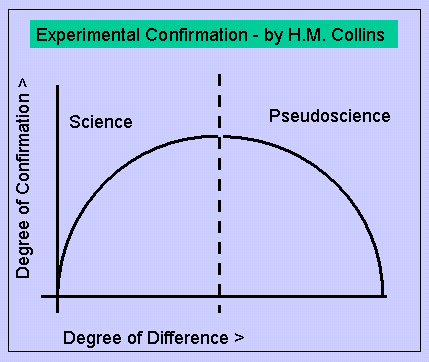
Transmission of Knowledge
Collins presents the concept of the "transmission of knowledge." He relates his experience in investigating the evolving replications of a unique gas laser, a transversely excited atmospheric pressure CO2 laser, also known as the TEA-laser, as an example.
He chose the example of the TEA-laser because of its lack of controversy, "a piece of straightforward 'normal' science where no one doubted that the phenomenon could be replicated."
"Early in 1970," Collins writes, "when no one else had yet achieved a successful gas laser operation at pressures above about half an atmosphere, a Canadian defense research laboratory, which I will call 'Origin,' announced the TEA-laser."
"[I] decided to talk to scientists who were trying to build copies of the device in Britain," Collins writes, "and to find out what they did in order to replicate the original experimental finding."
By the summer of 1971, Collins had located seven British laboratories and visited six of them, and by the autumn of 1972, he had visited five others in North America.
Intentional Constraints in the Transmission of Knowledge
"I found that the transmission of the ability to build a TEA-laser was not a straightforward matter," Collins writes. "The flow of knowledge between the laboratories was constrained in a number of ways. There were some constraints . which emerged out of what seemed to be competition among laboratories.
"Thus, many communication links that could have proved useful to the less advanced centers were never realized . In some cases, the knowledgeable institution would not be completely open with members of the learning institution.
"Thus one scientist reported of a visit to another laboratory: 'They showed me roughly what it looked like but they wouldn't show me anything as to how they managed to [cause the effect]. I had not a rebuff, but they were very cautious.'"
Collins identified another tactic whereby an original researcher answered questions that were asked of him but withheld any further information.
"'Let's say I've always told the truth, nothing but the truth, but not the whole truth,'" the researcher remarked.
Tacit Knowledge: Unintentional Constraints in the Transmission of Knowledge
Collins points out, however, that a more significant restriction in the flow of information exists, beyond those based on conscious concealment.
He refers to this as tacit knowledge, "the name given by Michael Polany to our ability to perform skills without being able to articulate how to do them."
"The standard example is the skill involved in riding a bicycle," he writes. "No amount of reading and study in the physics and dynamics of the bicycle will enable a novice to get on and ride immediately. On the other hand, the skilled rider is usually quite unable to describe the dynamics of balance involved."
Consider, for example, the case of an electrochemistry experiment. An originator of an experiment may have developed expertise in a particular method, let's say the co-deposition method, over the course of 18 years. And throughout this time, the requisite skills may have become so second nature that the originator may be wholly unconscious of the knowledge that must be transferred. Because the replicator does not know what he or she does not know, tacit knowledge becomes the most insidious impediment to successful replications.
The Experimenters' Regress
Collins speaks of a concept he calls the "experimenters' regress." He uses the example of building a gravity wave detector. The regress is, in a way, like a computer program stuck in an endless loop -- in other words, like a dog chasing its tail.
An experimenter approaching the experiment for the first time needs to know what the correct outcome should look like in order to build a good gravity wave detector. But until the experimenter has built a good detector and used it, he or she does not know what a correct outcome looks like.
"Experimental work," Collins writes, "can only be used as a test if some way is found to break into the circle. The experimenters' regress did not make itself apparent in [the chapter on the TEA-laser] because in [that case] the circle was readily broken.
"The ability of the laser to vaporize concrete, or whatever, comprised a universally agreed criterion of experiment [effectiveness]. There was never any doubt about when one was working and when it was not.
"Where such a clear criterion is not available, the experimenters' regress can only be avoided by finding some other means of defining the quality of an experiment; a criterion must be found which is independent of the output of the experiment itself."
Collins notes that the experimenters' regress is a real problem when scientists disagree on the effectiveness of particular detectors. This has been the case so far with calorimetry measurements from "cold fusion" experiments. A universal, independent detector does not exist to provide "proof" of the excess heat claimed from such experiments.
Current Limits of the Scientific Method
In gray areas, Collins notes, some scientists have a tendency to get personal.
Regarding another set of challenging replications, this one involving gravitational wave detectors, one scientist stated, "I think that the group at . W . are just out of their minds." Another said, "I am not really impressed with his experimental capabilities so I would question anything he has done more than I would question other people's." And another unabashedly exclaimed, "That experiment is a bunch of shit!"
With regard to an experiment Collins labels "Z," he relates the colorful variety of responses from other scientists:
Scientist 1: "Z's experiment is quite interesting and shouldn't be ruled out just because the . group can't repeat it."
Scientist 2: "I am very unimpressed with the Z affair."
Scientist 3: "Then there's Z. Now the Z thing is an out and out fraud!"
Collins brings in a quote from a more empathic scientist who realizes that "it's very difficult to make a carbon copy."
"You can make a near one," the scientist says, "but if it turns out that what's critical is the way he glued his transducers, and he forgets to tell you that the technician always puts a copy of Physical Review on top of them for weight, well, it could make all the difference."
Another scientist tells Collins, "Inevitably, in an experiment like this, there are going to be a lot of negative results when people first go [about it] because the effect is that small, [and] any small difference in the apparatus can make a big difference in the observations. . I mean, when you build an experiment, there are lots of things about experiments that are not communicated in articles and so on."
When the circle of the experimenters' regress has not been broken, Collins points out, a set of "nonscientific" criteria may be offered by scientists "for their belief or disbelief" in the results of surprising results.
The list includes:
- "Faith in experimental capabilities and honesty, based on a previous working partnership.
- Personality and intelligence of experimenters.
- Reputation of running a huge lab.
- Whether the scientists worked in industry or academia.
- Previous history of failures.
- 'Inside information.'
- Style and presentation of results.
- Psychological approach to experiment.
- Size and prestige of university of origin.
- Integration into various scientific networks.
- Nationality."
Collins spoke with one scientist who summed up the matter: "You see, all this has very little to do with science. In the end, we're going to get down to his experiment, and you'll find that I can't pick it apart as carefully as I'd like."
Collins' insight into the significance of degrees of difference as it pertains to condensed matter nuclear science research is profound. For many years, rejecters of the hypothesis of low energy nuclear reactions have refused to accept a wide variety of experimental results in this field, citing various experiments performed with less than 100 percent similarity as unqualified replications.
Now, it seems, hundreds, perhaps thousands of experiments that have used a variety of methods and materials and have attained results more or less in the same ballpark are not only valid replications, but also strong replications and the assertion by critics of inadequate replication may have been flawed.
__________________________________________________________________________________
2. To the Editor: The Mystery of Reproducibility
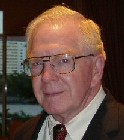 by Charles G. Beaudette by Charles G. Beaudette
This article discusses the core mystery and problem of condensed matter nuclear science — reproducibility — as it appeared in 1989. (Some of the following ideas are also contained in my article "Response to the Department of Energy/2004 Review of Cold Fusion Research.")
We start with an acknowledgment that the term “cold fusion” is a misnomer. The field called cold fusion predicates the existence of a source of heat energy new to science and first demonstrated in the Martin Fleischmann - Stanley Pons experiment that was announced on March 23, 1989, at the University of Utah.
In a simultaneous hypothesis, Fleischmann spoke of that source as derived from an unknown nuclear reaction channel. Although some cold fusion reactions of deuterium - deuterium (producing energetic neutrons) were reported, he asserted that they contributed, at most, to only one part in a billion of the measured heat energy. This well-known fusion reaction channel is not the source of the excess heat energy in his experiment.
Theoretical studies that developed from the field’s experimental work to date provide several directions for possible identification of the reaction channel, but these theories remain incomplete. The mystery of difficult reproducibility, in a first-order consideration, results from a lack of theory as a guide. We don't know what parameters to control in the design of the experiment nor how to interpret its outcome.
Experimental evidence for this new source of energy continues to be abundant. The original 10-week experiments by Fleischmann and Pons at the University of Utah show in the peer-reviewed literature well-documented evidence of a new source of heat energy, now called excess heat, exhibited in large amounts relative to the accuracy of their calorimeter.
The vicious and personal disparagement of Fleischmann and Pons at the American Physical Society meeting in May 1989 at Baltimore effectively ended serious evaluation of their heat energy claim by the institutional scientific community. Fleischmann's presentation at the National Science Foundation/Electric Power Research Institute meeting in October 1989 was impressive, with its extensive replication of heat energy production. The lack of critical discussion of these results by Nathan S. Lewis of Caltech, who was present, showed the heat generation effect to be scientifically defensible.
Subsequent confirmation in the laboratories of Richard A. Oriani, University of Minnesota, and Michael McKubre, SRI International, each during 1989, provided sufficient corroboration for those with a professional interest in the field to proceed with some confidence that they were studying a real effect. Excess heat established itself as an experimental fact in the peer-reviewed literature by the end of 1994, even though that was achieved using solitary — nonreproducible — experiments.
The public demand by John R. Huizenga, University of Rochester, for full reproducibility was mistaken and damaging to the new science. He turned the science establishment away from the difficult and expensive task of evaluating heat generation in an experiment of limited reproducibility. Large sections of science, such as cosmology, work without reproducible experiments. Other specialties work with difficult reproduction: for example, angiogenesis and cloning. The financial and professional effort needed for institutional confirmation of these experiments may be comparable with that required of the J. Folkman angiogenesis experiment. A series of these difficult experiments, including the original Fleischmann-Pons experiment, with its particular calorimetry, may cost millions of dollars. Development of the field of cold fusion was thus wrongly inhibited for more than a decade.
Why do experiments that give excess heat resist reproducibility? I attribute this limitation to the difficult environment of condensed matter in the solid state. Materials science does poorly in controlling solid-state structure at the atomic level, except when making single crystals. The functional question about reproducibility is, How are we to fabricate 100 cathode elements in such a way that each has an identical atomic structure, thus permitting 100 experiments to be performed, each starting under the same initial conditions? Mankind does not know how to fabricate material with such absolute atomic control.
So how did we proceed? It was necessary to find an experimental configuration that is more insensitive to the internal atomic structure of the cathode element. Some progress has been made in this direction since 1989, but this paper will not portray that development.
What can be done profitably at this point is to review the literature for an experiment that is inexpensive to run, offers airtight evidence of heat and nuclear action and gives promise of reproducibility. Fortunately, several simpler experiments are now available to our field and might be pursued to achieve successful replication in multiple laboratories. These ideas properly have been the topic of much discussion in the CMNS community.
Next, try to find an organizational milieu within which the reproducibility, the “secondary” effort, can be pursued. This is difficult because most scientists, with the meager funds now available, want to do original and publishable work --- what might be called “primary” work. The kind of “secondary” task needed here is not funded at present.
The leadership of New Energy Times, and its parent organization New Energy Institute, a 501(c)(3) nonprofit organization dedicated to the advancement of this field, might be just the way to get this important, but secondary, research accomplished. Steven Krivit's selection of the SPAWAR experiment is most commendable and deserves our professional and financial support.
(Letters may be sent to "letters" at the New Energy Times domain name. Please include your name, city, and state or province.)
__________________________________________________________________________________
NEWS & ANNOUNCEMENTS
3. The 13th International Conference on Condensed Matter Nuclear Science (ICCF-13)
Conference chairman Yuri Bazhutov reports that the 13th International Conference on Condensed Matter Nuclear Science will take place June 25 - July 1, 2007, in Sochi, Russia, at the Dagomys Hotel.
The Web address for the conference is http://www.iscmns.org/iccf13.
The deadline for abstracts is January 25, 2007.
 The International Conference on Condensed Matter Nuclear Science series originated from the discovery announced in March 1989 at the University of Utah by Martin Fleischmann and Stanley Pons of an electrolysis experiment with heavy water that yielded excess heat. The International Conference on Condensed Matter Nuclear Science series originated from the discovery announced in March 1989 at the University of Utah by Martin Fleischmann and Stanley Pons of an electrolysis experiment with heavy water that yielded excess heat.
Their interpretation of the observed phenomenon indicated a possibility of initiating nuclear reactions at normal temperature. This novel approach contradicted prevailing nuclear physics knowledge and caused a worldwide scientific uproar. When the arguments faded, a new direction in modern physics appeared: condensed matter nuclear science.
This new direction has been supported by many research groups and qualified researchers in more than 30 countries. In some of the countries, these research activities have received federal support as well as participation from businesses of all sizes.
This is the 13th international conference in this series. According to the International Advisory Committee, the main subjects and goals of the conference should encourage collaboration with researchers who have expertise in the fields of nuclear engineering, mechanical engineering, electrical engineering, laser science and engineering, material science, nanotechnology and biotechnology to accelerate the solution to these research problems.
The special aspect of ICCF13 is that, according to the tradition of the annual Russian conferences, the scope of the problems to be considered incorporates the theoretical and experimental research related to the phenomena of nuclear transmutations in condensed matter and in gaseous and plasma media of another important investigation in modern science: the nature and likely phenomenon of ball lightning.
Optimistic expectations of quickly solving the energy problem based on these newly discovered principles are not yet justified. However, the developing research efforts now indicate a confident view that a new field of scientific activities has opened in modern science.
Reasonable expectations exist of finding not only new solutions to a number of fundamental problems about the origin and interaction of matter and energy in the universe but also a number of breakthrough technologies that may bring significant benefits to society.
A number of research groups are transferring knowledge gained in laboratory investigations of the phenomena of low energy nuclear reactions in condensed matter to valuable technologies and technical projects.
We believe that the physics of low energy nuclear reactions in condensed matter will take one of the leading roles among the brand new directions of developing science and technology in the 21st century. The future definitely will come! Remain vigilant and maintain foresight with regard to the reality and potential importance of this field of research.
__________________________________________________________________________________
4. Other Upcoming Conferences
American Physical Society March Meeting - March 5-9
Denver, Colorado, USA
Web site: http://aps.org/meetings/march/index.cfm
American Chemical Society Meeting - March 25-29
Chicago, Illinois, USA
Web site: http://www.envirofacs.org/233%20-%202007%20Spring%20Chicago/New%20Energy.htm
International Conference on Emerging Nuclear Energy Systems - June 3-8
Istanbul, Turkey
Web site: http://newenergytimes.com/conferences/2007/ICENES2007/ICENES2007.shtml
__________________________________________________________________________________
5. Excerpts from Cold Fusion: Fire from Water on Google Video
New Energy Institute (www.newenergytimes.com) is pleased to announce a recent collaboration with the New Energy Foundation (www.infinite-energy.com). New Energy Institute has released an edited version of the phenomenal 1999 documentary Cold Fusion: Fire from Water, produced by Eugene Mallove and the New Energy Foundation, and is making it available at no cost via the Internet. Mallove was a visionary who saw the potential of this scientific phenomenon. This brilliant film captures the heart of the new field of condensed matter nuclear science, in which ongoing research is demonstrating stronger and stronger evidence that there is hope for a better solution to the world's energy and environmental problems.
Edited by Steven B. Krivit and released by New Energy Institute with permission from the New Energy Foundation.
The film is available at Youtube
__________________________________________________________________________________
6. What Really Happened with Cold Fusion, and Why Is It Coming Back?
This talk was presented on November 1, 2005 in San Francisco, California at the International Congress on Nanotechnology by New Energy Times editor and New Energy Institute executive director Steven B. Krivit.
The first part of this talk summarizes the political history of mainstream science's failure to recognize cold fusion both as a legitimate science and as a possible new source of energy. It explains how, in 1989, mainstream science threw out the baby (the excess heat) with the bath water (the botched Fleischmann and Pons theory and neutron claims). The second part of the talk briefly reviews three experimental studies in cold fusion.
__________________________________________________________________________________
7. Glenn T. Seaborg Describes His Role in Advising President George H.W. Bush on Cold Fusion
The Department of Energy's 1989 review of cold fusion was doomed from the start. Glenn T. Seaborg, Nobel prize winner in chemistry and chairman of the Atomic Energy Commission for a decade, was called to the White House to brief the president of the United States on the cold fusion discovery. This video contains two excerpts from a lecture by Seaborg at the Lawrence Berkeley National Laboratory on October 28, 1995 in which it is apparent that he rejected the possibility of cold fusion on theoretical grounds and saw himself as protecting the public from bad science.
The film is available at: http://www.youtube.com/watch?v=14_YTxigT3E
[The above description of the video is not copyrighted and may be reposted without permission on the condition that the text is used unedited and in its entirety.]
__________________________________________________________________________________
ANALYSIS AND PERSPECTIVES
8. The Cold Fusion Short Story
By Steven B. Krivit
In a press conference on March 23, 1989, two chemists, Dr. Martin Fleischmann and Dr. Stanley Pons at the University of Utah made three claims. The most significant of these claims was the discovery of a method of generating energy from a nuclear source in the form of heat in a way that was previously unrecognized by nuclear physicists.
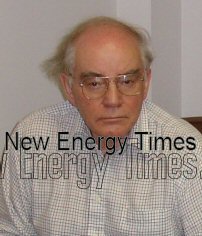
Martin Fleischmann
Photo: Hywell Rees |
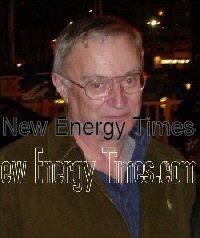
B. Stanley Pons
Photo: Steven Krivit |
In Fleischmann and Pons' experiment using the elements palladium (a precious metal) and deuterium (a form of hydrogen), they observed 1,000 times more heat coming from the reaction than could be explained by any known chemical reaction. [Click here for their paper.] This discovery, which yielded excess heat, became popularly identified as cold fusion.
Their discovery not only appeared to contradict prevailing theory but also generated more energy, watt for watt, than the hot fusion physicists had made in their attempts over the previous 38 years.
| The magnitude of the surprise, disbelief and anger of many nuclear physicists cannot be overestimated. The claim of excess heat without dangerous radiation at room temperature was startling. Within one month of the announcement, IBM physicist Richard Garwin said, "Large heat release from fusion at room temperature would be a multidimensional revolution. I bet against its confirmation."
Whenever this controversy is finally settled, it is possible that scientists may agree that some other novel nuclear mechanism, but not fusion, is responsible for the phenomena. The bet in 1989, and for much of the early cold fusion history, was that all of the Fleischmann-Pons claims were entirely without substance and that the new source of energy was a mistake, "pathological science" and a delusion. |
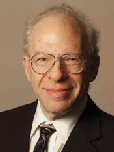
Richard Garwin |
The two chemists and their discovery of the cold fusion effect posed an uncomfortable challenge to fundamental concepts held by nuclear physicists.
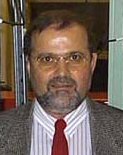
Moshe Gai
|
"If cold fusion is true, then all of this is wrong," Moshe Gai of Yale University said as he gestured toward the wall of books behind him while he talked to author Charles Beaudette in the mid-1990s.
Gai, like Garwin, is a prominent nuclear physicist who played a public and highly critical role in the early cold fusion controversy. He, too, found the hypothesis of excess heat inconceivable.
Only a few physicists have been willing to consider the possible reality of the cold fusion excess heat effect publicly. J. Reece Roth, head of the industrial plasma engineering group at the University of Tennessee, is one such person. |
"If professor X.Z. Li [Tsinghua University, Beijing, China, who has studied both hot and cold fusion research] is correct," Roth said, "then I'll have to throw away about 14 of the 16 chapters in my book Introduction to Fusion, because it will no longer be relevant to the kinds of fusion that could result from this 'cold fusion' process."
The discoverers, while confident about the core of their discovery, excess heat, were unable to explain other aspects of their experiment. Fleischmann and Pons also made a significant error with their neutron/gamma measurements that caused confusion and aroused suspicion.
Fleischmann and Pons made other mistakes too; they exaggerated their claims by making an extrapolation with their data and breached several professional protocols.
However, they did not make significant errors with regard to their discovery of excess heat, which has been validated many times. |
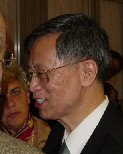
Xing Zhong Li |
To the nuclear scientists of the day, the claims of Fleischmann and Pons were just too much: too many miracles and too many contradictions. It looked like nonsense, and it was far easier to dismiss it than to consider it seriously.
Although none has admitted it, outspoken nuclear physicists didn't seem to like the idea of two chemists trumping them, and they didn't like the idea that two chemists claimed to have found a way to generate nuclear energy with laboratory equipment far simpler and less expensive than their own.
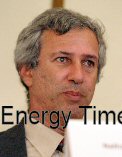
Nathan Lewis
Photo: Amy Tierney
|
The initial rejection and much of the continuing debate have been highly emotional reactions to the intellectual challenge presented by the cold fusion claims.
Initially, several laboratories asserted that they had debunked the cold fusion claims. Researchers at Caltech and MIT led the charge. David Goodstein, California Institute of Technology vice provost and professor of physics, wrote that his colleagues Steven Koonin and Nathan Lewis "executed between them a perfect slam-dunk that cast cold fusion right out of the arena of mainstream science."
MIT professors Ronald R. Parker and Ronald G. Ballinger gave an interview to the Boston Herald and alleged that Fleischmann and Pons had committed science fraud. After the defamatory story hit the newswires, Parker denied making such accusations. An audiotape of this interview, however, supports the Herald and its journalist Nick Tate. [Recording: Side one 10Mb, Side two, 5Mb] |
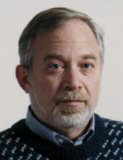
Ronald G. Ballinger
|
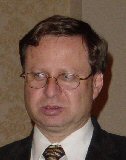
Steven Koonin
Photo: Steven Krivit |
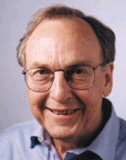 Ronald R. Parker
Ronald R. Parker |
It was a tall order to expect scientists to figure out the cold fusion phenomenon in a matter of weeks. Because of the lack of information available, it is unlikely that researchers at Caltech and MIT were able to create the proper experimental conditions to initiate and measure the cold fusion effect. However, there is one instance at each laboratory where the data may indicate a very small positive result. In both cases, evidence shows that researchers at Caltech and MIT shifted their data to eliminate any possibility of the appearance of a positive effect.
The resistance to the idea of cold fusion led to a turf war between many chemists and physicists. The two disciplines use different tools for observation and for measurement. They also have different protocols for the assessment and acceptance of empirical findings.
|
"Ordinarily, new scientific discoveries are claimed to be consistent and reproducible; as a result, if the experiments are not complicated, the discovery can usually be confirmed or disproved in a few months. The claims of cold fusion, however, are unusual in that even the strongest proponents of cold fusion assert that the experiments, for unknown reasons, are not consistent and reproducible at the present time. However, even a single short but valid cold fusion period would be revolutionary."
- Dr. Norman Ramsey, Nobel laureate and professor of physics at Harvard University was the only person on the the 1989 Department of Energy cold fusion review panel to voice a dissenting opinion. Ramsey insisted on the inclusion of this preamble as an alternative to his resignation from the panel. |
|
Some physicists considered the use of the term "fusion" by Fleischmann and
Pons illegitimate, even sacrilegious, because the evidence conflicted with their conventional understanding of fusion. They considered use of the word to be disrespectful to science.
Adding fuel to the fusion controversy was the fact that billions of dollars of research funds earmarked for physicists were at risk. This may have been another reason why many physicists were reluctant to accept the chemists' evidence.
One of the most common and invalid critiques used to reject the excess heat claim was "the absence of a convincing theoretical argument," as Mark Mac Low, an astrophysicist with the American Museum of Natural History, wrote in 2006. This criticism reflects a
departure
from the scientific method.
A scientific observation, at its beginning, does not require a working theory. In simple terms, this objection puts the cart before the horse. The foundation of scientific exploration is experiment, not theory. In other words, "theories guide, experiments decide."
Another common argument, also presented by both Mac Low and Garwin, is the suggestion that the claims of cold fusion are the result of measurement error or poor experimental design. [Click here for an analysis of these arguments by Edmund Storms.]
Critics, including Garwin, who visited the SRI International laboratory in Menlo Park, Calif., and the Laboratoire des Sciences Nuclearies in Paris, which was funded in part by Shell Petroleum, failed to find the errors that they allege would account for the many years of laboratory results supporting the claim of excess heat. They have, at times, found errors but none that was significant enough to refute the claims.
Those who still reject the field in its entirety are often well-intentioned, however un- or misinformed scientists, who believe they are protecting the public from false science.
In 2004, Garwin cautioned one journalist that endorsing cold fusion could "break the bank on supporting bad science, and even worse, pollute our political and scientific process by false arguments that the money is being well spent and progress is being made."
In the same letter, Garwin broadly attributed the claims of cold fusion researchers to "self-delusion."
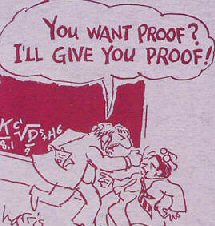 |
Naturally, the burden of proof for any extraordinary claim is on the claimant, and skeptics are not required to accept a claim until they are shown extraordinary evidence that they deem satisfactory. "Proof," however, is a personal, subjective criterion; it varies from one person to another and consequently cannot provide an effective universal benchmark, particularly in controversial science.
Skeptics also have a responsibility. If they wish to assert the claim of procedural or experimental error, they have an obligation to identify the error explicitly.
Vague, general assertions are meaningless and unsupportable -- and fall under the
category of pathological skepticism.
Worse, the broad allegation that
all cold fusion researchers are suffering from self-delusion is arrogant
and prejudicial, if not dishonorable. At some point, this scientific episode will provide deep insights into the nature of many scientists and their reactions to new paradigms. |
Most scientists who attempted to replicate the Fleischmann-Pons experiment initially failed. However, a few succeeded – some by luck, others because of prior related electrochemistry experience. Those who succeeded shared three common factors.
First, they considered the Fleischmann-Pons claim seriously rather than responding with ridicule. Second, they assumed the experiment was not at all as simple as reported by the press. Third, they were patient, allowing many months to learn about, test and implement their replications.
Most of the arguments against the claim of excess heat, including one that calls it “pathological science” and another demanding 100 percent repeatability, have been little more than a smokescreen by scientists who were simply astounded by the novelty of low energy nuclear reactions, the scientific term for the cold fusion phenomena.
Most physicists see science like mathematics: formulaic and predictable. [Click here for an analysis of proof and the scientific method by Charles Beaudette.] They expect and demand that valid experiments be highly repeatable by their originators and reproducible by their peers.
Many nuclear physicists have demanded 100 percent repeatability before
being willing to take the cold fusion field seriously. This demand, and the
underlying motive, are suspect. Some scientific disciplines -- geology and
astrophysics, for example -- do not demand 100 percent repeatability.
Sharon Begley of The Wall Street Journal was one of the first journalists to recognize the larger problem.
"The only thing pathological about cold fusion," Begley said, "is the way the scientific establishment has treated it."
According to the strict protocols of science -- "the rules," as some scientists call them -- the validation of the excess heat effect by Fleischmann and Pons at the University of Utah has followed scientific protocol. [Click here for Storms' "Objective Assessment" paper.] The experiments have been performed with rigor, good signal-to-noise ratios, and controls. Independent researchers have replicated them, using a variety of methods and publishing in peer-reviewed journals.
The excess heat effect cannot be repeated and reproduced on demand by more than a handful of researchers. However, the general reasons for this are well-understood. Although some people choose to see the reproducibility challenge as a glass half empty -- and use this as justification to dismiss the entire field -- other people see a glass half full, the possibility of a major new field of science and technology.
Despite acrimonious comments by would-be critics in popular media, the majority of scientific papers supporting low energy nuclear reactions and published in peer-reviewed journals have never been challenged, let alone refuted. This includes the seminal Fleischmann-Pons paper from 1990 and the first published replication by Richard Oriani, also in 1990.
Technically, the subject matter is complex. It is not at all a routine science problem to solve or understand. Neither were the discoveries of radioactivity and semiconductors.
The attempt to refute the Fleischmann-Pons claims in the span of six weeks was, in retrospect, ludicrous, particularly for a multi-disciplinary subject like the low energy nuclear reactions in condensed matter.
When new science with broad potential impact is discovered, a true community of experts from various fields must come together to reach an honest and accurate judgment of the discovery on behalf of society. This process takes time and patience, and that was sorely lacking in the cold fusion episode. We can only hope that this historic temporary failure of the scientific method will serve as a lesson reminding us to handle tomorrow's controversial science discoveries more wisely.
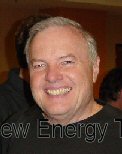 |
"We do not know if cold fusion will be the answer to future energy needs, but we do know the existence of the cold fusion phenomenon through repeated observations by scientists throughout the world. It is time that this phenomenon be investigated so that we can reap whatever benefits accrue from additional scientific understanding."
-- Dr. Frank E. Gordon, head of the Navigation and Applied Sciences Department of the Navy’s Space and Naval Warfare Systems Center in San Diego
|
|
|
__________________________________________________________________________________
9. Low Energy Nuclear Reactions and Condensed Matter Nuclear Science Defined
LENR, historically known as cold fusion, are:
- A potential source of clean nuclear energy.
- A scientific discovery that was and remains the subject of great controversy.
- Nuclear reactions that generate energy in laboratory experiments, primarily in the form of heat and/or nuclear transmutations without harmful radiation, nuclear waste or greenhouse gases. They use hydrogen, from a variety of sources, as their fuel source.
Low energy nuclear reactions can occur at or near ordinary room temperature. The term "cold fusion" was applied to this field of research initially by the press, not by its discoverers. Many people thought and still believe that it is a form of fusion; however, this claim is speculative.
Initially, the term "cold fusion" distinguished this research from "hot" fusion, also known as thermonuclear fusion or plasma fusion. Hot fusion experiments require multimillion-degree temperatures. Since 1951, when hot fusion research began in the U.S., researchers have not succeeded in generating any useful energy from hot fusion.
The term "cold fusion" was never ideal to describe low energy nuclear reactions, because it implied that they were just a colder form of hot fusion, which they are not. The term was adopted by the media in 1989, appearing first in the Wall Street Journal, as a result of confusion with another type of fusion, called muon-catalyzed fusion. LENR's benign byproducts distinguish them from both traditional hot fusion and a variety of new hot fusion experiments that also can run in room-temperature laboratories.
LENRs often use for their fuel a form of hydrogen called deuterium, which comes from water. One in every 6,000 water molecules contains deuterium. The energy available in the deuterium in one cubic mile of seawater, if used for fusion power, exceeds the energy capacity of all the known fossil fuel reserves in the world.
A variety of models has been proposed to explain LENR. Some do not even involve fusion processes. Under the correct conditions, fusion occurs when the nuclei of two deuterium atoms come very close to each other. When this happens, they combine to make helium and a large amount of heat. The hypothesis of an actual fusion mechanism remains speculative; however, the evidence of some as-yet-unexplained source of heat is well-established in the published scientific literature.
Theoretically, fusion of hydrogen can generate 8 million times more energy than the same amount of hydrogen if it were burned in a chemical reaction. Some researchers report LENR experiments using both normal water and machine oil doped with boron.
Condensed Matter Nuclear Science
Condensed matter nuclear science includes multiple subject matters including low energy nuclear reactions, an entirely new branch of science that gained widespread attention beginning in 1989 with the Fleischmann-Pons "cold fusion" announcement at the University of Utah.
The collective group of experimental observations is called low energy nuclear reactions, which may include fusion reactions as well as nonfusion nuclear reactions. The word "low" refers to the input energies to the reactions; the output energies may be low or high. The practical aspects of this research remain to be fully explored.
Condensed matter nuclear science studies nuclear effects in and/or on condensed matter, targeting its application for portable clean nuclear sources. It is an inter- and multidisciplinary academic field encompassing nuclear physics, condensed matter physics, surface physics and chemistry, and electrochemistry. CMNS applications involve many other fields as well, including nuclear engineering, mechanical engineering, electrical engineering, laser science and engineering, material science, nanotechnology and biotechnology.
The term “condensed matter nuclear science” evolved from the discussion and input of many individuals during the May 2002 ICCF Advisory Committee meeting in Beijing, China.
A significant set of phenomena that has been observed in the field of condensed matter nuclear science involves the anomalous production of heat and helium-4 in various metal deuterides and hydrides. In some circumstances, liquid media act as condensed matter and take the place of the metals. Several theories involving low energy nuclear reactions have been proposed to explain the experimental observations.
The nuclear effects in condensed matter are not limited to the reactions that yield heat and helium-4. In fact, a wide variety of effects has been observed, including nuclear transmutation reactions. All of the observed reactions appear to lack high-energy neutron fluxes and strong gamma ray emissions and thus show promise of new types of nuclear reactions that can occur without the need for complex containment or disposal systems.
Low levels of radiation are found in at least some of these reactions, but this radiation is usually absorbed directly within the experiments. As a result, the nature of the effects suggests a system that is safe, potentially eliminating the environmentally unfriendly issues that exist with conventional nuclear fission and fusion reactions. However, much more testing must be performed to better understand any potential health or environmental risks.
(Akito Takahashi, David Nagel and Mike Carrell contributed parts of this text)
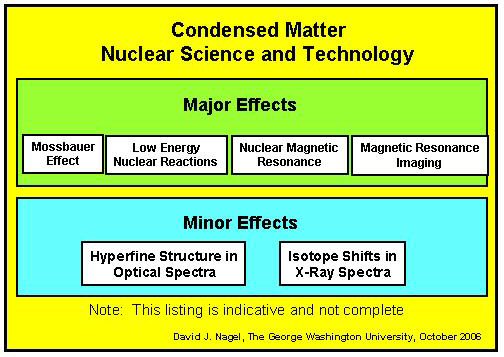
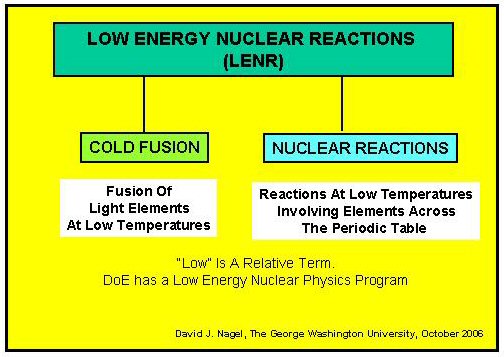
__________________________________________________________________________________
10. My Cold Fusion Talk at the Atheneum of Madrid
by Conrado Salas Cano
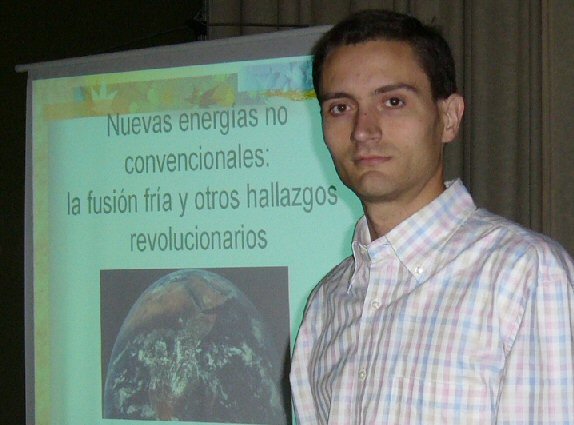
Photo: Carla Salas Cano |
It was with great excitement that I presented a public lecture on cold fusion at the Atheneum of Madrid, Spain, on November 25, 2006. The Atheneum is an old and esteemed cultural center, where very illustrious people have spoken, so it was a great honor to be invited to speak there.
This was my first chance to reach a wide audience to discuss the latest developments in this research field, which is more than dear to me.
I had informed science journalists from the major Spanish newspapers about my talk in advance. I also had announced my talk to leading national energy companies and magazines. I do not know whether any of these people were among the 80 that filled the room. |
One of the interesting people who attended was professor Carlos Sánchez López from the Universidad Autónoma de Madrid, who may have been the only researcher in Spain who attempted a Fleischmann-Pons replication in 1989. Bartolomé Luque, a nationally known science popularizer and skeptic, attended my lecture, as well.
The interest and anticipation was high because the topic was known to be controversial. When the organizer, Juan Fuertes, introduced me, he challenged me to convince him that cold fusion could work. I think I did.
I started my presentation recognizing all the conventionally proposed energy alternatives (solar, wind, geothermal, biomass), pointing out that I was supportive of all of them but that we needed to explore further options.
These other options are still little-known, poorly understood, and plagued with many challenges, yet they show fabulous promise and deserve exploration. The implications of harnessing a potentially new, cheap, and clean form of energy are simply earthshaking.
I launched into the major topic of the talk: cold fusion. I summarized the Fleischmann-Pons episode as portrayed by the media, then reviewed the work of Melvin Miles, formerly of the U.S. Naval Weapons Center in China Lake. Miles had performed analyses of the replication attempts of Nathan Lewis of Caltech and others, and he found that the results were far from conclusive and, in fact, may have shown small positive signals of excess heat. Lewis did not report this but rather adjusted the calibration constant so the signals of possible excess heat zeroed out.
I picked some of the quotes of experts in cold fusion to illustrate to newcomers the promise of the field and added Arthur C. Clarke’s unabashed description of the treatment of cold fusion as "perhaps one of the greatest scandals in the history of science."
I elaborated a bit on the kinds of experiments performed so far, citing the observation of heat, helium, occasional neutrons, and element transmutation. I talked about the impressive 70 watts which Akito Takahashi, of Osaka University, once achieved and the fact that it was thrice the input.
I discussed the typical attained power densities and the improvement in repeatability (45 to 83 percent) over five years. I spoke of some of the quantum-electrodynamic and phonon solid-lattice theories that have been put forward by researchers in the U.S. and Japan to explain how the Coulomb barrier might be overcome. I also mentioned Jean Pierre Vigier’s ideas on the shrinking of Bohr orbits under strong magnetic fields.
I discussed the lukewarm latest DoE review and compared the pricetag of Edmund Storms’ (formerly of Los Alamos national laboratory) aging home apparatus ($50,000) with that of the Joint European Torus hot fusion reactor ($1 billion). I discussed other new energy inventions and zero-point energy topics.
People really got fired up and later bombarded me with questions. I heard repeatedly that the talk had been a smashing success.
Click here to hear an audio version of Salas Cano's report.
Conrado Salas Cano began his post-secondary studies in his hometown at the University of Zaragoza in Spain. He then transferred to California Institute of Technology. As part of his evaluation, his background in chemistry was reviewed by Caltech professor Nathan Lewis, famous for his so-called debunking of cold fusion. Salas Cano completed his bachelor's degree in physics at Caltech with honors in 1998. Afterward, Salas Cano requested that cold fusion research be resumed at Caltech, but his proposal was turned down. He enrolled at Portland State University and completed a master's degree in physics. While at Portland State, he successfully carried out his master’s thesis "cold fusion" experiments under the tutelage of professor John Dash.
__________________________________________________________________________________
11. SCIENCE AND ENERGY NEWS
Click on headline to read the entire article.
Wal-Mart Puts Some Muscle Behind Power-Sipping Bulbs
New York Times
Tuesday, Jan. 2, 2007
As a way to cut energy use, it could not be simpler. Unscrew a light bulb that uses a lot of electricity and replace it with one that uses much less.
While it sounds like a promising idea, it turns out that the long-lasting, swirl-shaped light bulbs known as compact fluorescent lamps are to the nation’s energy problem what vegetables are to its obesity epidemic: a near perfect answer, if only Americans could be persuaded to swallow them.
But now Wal-Mart Stores, the giant discount retailer, is determined to push them into at least 100 million homes...
Light-bulb manufacturers, who sell millions of incandescent lights at Wal-Mart, immediately expressed reservations. In a December 2005 meeting with executives from General Electric, Wal-Mart’s largest bulb supplier, “the message from G.E. was, ‘Don’t go too fast. We have all these plants that produce traditional bulbs,’ ” said one person involved with the issue, who spoke on condition of anonymity because of an agreement not to speak publicly about the negotiations...
(article continues)
________________________________________________________________________________
Support New Energy Times(tm)
New Energy Times (tm) is a project of New Energy Institute, an independent 501(c)(3) nonprofit corporation that provides information and educational services to help bring about the clean-energy revolution.
The New Energy Times (tm) newsletter, Web site, and documentary projects are made possible by the generous contributions of our sponsors and supporters.
We invite you to join with us in this effort to help bring about a better future for all of earth's current and future residents.
__________________________________________________________________________________
Administrative
Copyright 2007 New Energy Times (tm)
Publication, in print or electronically, is not permitted without express written permission.
|

